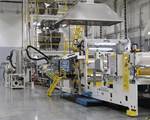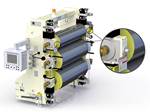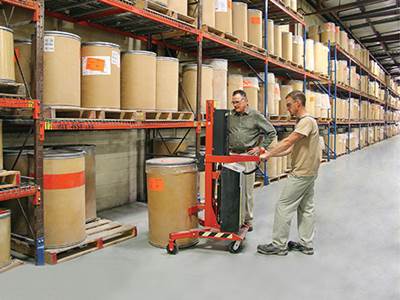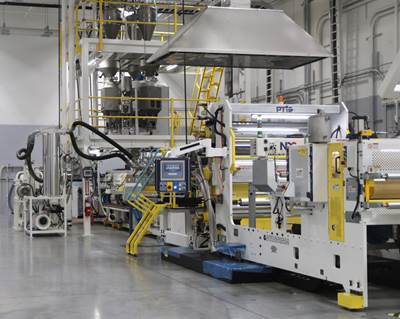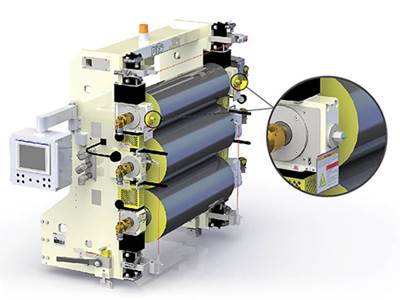The COVID-19 pandemic has placed personal protective equipment (PPE) front and center. PPE devices such as face shields are critical in protecting healthcare and other essential workers from viral airborne particulates. These shields, made from FDA-approved clear sheet, are used in several industrial and laboratory environments but have also proven their worth in many other environments during the pandemic.
What extrusion equipment is needed to make clear PPE sheet? A typical PPE sheet line includes an extruder or extruders, adapter network, roll stand and winding system. Typical resins include PET, PETG, PMMA, PC, crystal (general-purpose) PS and PP, or a combination thereof. Rates vary based on extruder size and resin used (see Table 1). In terms of feed screws, a single-stage barrier is ideal for PET, RPET, PETG, PP and PC, and two-stage screw is recommended for PS and PMMA applications.
Welcome! You’ve unlocked premium content.
If you already have a sheet line or are looking to add a new one for PPE production, it’s important to evaluate each component to ensure effectiveness, cost-efficiency, and the value proposition for your business. Here are some considerations for the primary components of a sheet extrusion line to produce PPE sheet.
Extruder Requirements
Whether using existing equipment or buying new, the extruder must have sufficient torque to process the selected resin or possibly a speed increase for improved rate.
For existing extruders:
- • Evaluate motor horsepower and base gear in speed.
- • Understand available extruder torque versus required torque for resins to be processed.
- • Know the rated torque limit of the existing extruder gearbox; do not exceed the rating.
- • Belt-drive extruder gearboxes can be modified by changing the sheave ratio to meet the desired torque and/or gear in speed increase.
- • A direct-coupled motor gearbox may require a gear-ratio change.
For new equipment:
- Ensure capabilities are engineered for a range of resins.
- • Include extended-field-range motors.
- • Consider vented and plugged extruder barrels for greater flexibility.• • Choose a flexible screw design for multiple materials as needed, or optimized screw designs to fit your requirements.
To support melt delivery from the extruder to the die on existing or new equipment, melt filtration is always a consideration. You can use a single slide-plate screen changer for virgin, or clean in-house regrind/resin blends. When looking to process rPET or other recycled materials, a continuous-type screen changer should be considered for uninterrupted runtime. Various styles of continuous units are available for sheet applications, with a dual-bolt rotary unit the most common for that application.
Melt Pumps
Since most sheet processes use a blend of regrind and virgin resin with variable bulk density, we recommend using a melt pump. Here’s why:
- • Melt pumps reduce the output pressure variability to the feedblock and die.
- • They improve machine-direction thickness control.
- • They support die performance for transverse thickness control (stable flow-through die manifold).
- • Melt pumps offer melt-stream bead stability in the roll-stand primary nip.
- • They operate around 700 to 1000 psi inlet pressure and 2000 to 3500 outlet pressure.
- • Special continuous leaking pumps can control leakage flow and prevent contamination of clear sheet.
- • Melt pumps are essential when using a two-stage screw design.
Die Selection
Dies built for the specific resin to be processed are always best. General-purpose dies will operate with some sacrifice of performance such as the need to adjust die lips more frequently due to resin pressure changes within the die. A restrictor bar may be required to allow processing a variety of materials, as this allows the operator a means of changing the die’s internal pressure distribution.
However, with some resins the associated internal parting line becomes a hang-up point for potential material buildup and degradation, resulting in potential black specs in the material (see Table 2). Another compromise to enable multiple-resin performance requires larger die bodies, which unfortunately push the die farther from the nip, creating other challenges.
General-purpose dies will operate with some sacrifice of performance.
Dies must be able to accommodate a sheet gauge of 8 to 32 mils and typical widths from 32 to 58 in. For die-lip radius, 25 to 50 microns are preferred versus the 150- to 200-micron standard.
Roll-Stand Configurations and Purpose
Choosing the right roll stand is also important. Here is a summary of each type:
• Vertical downstack: Conventional arrangement; horizontal die-to-nip approach; improved operator visibility; equal web wrap; smooth sheet processing. Lower melt-strength resins should use a smaller-diameter top roll. Recommended for PMMA.
• J-stack: Most flexible design with an angled die-to-nip approach; good for low-melt-strength resins; vertical top and center roll for improved operator visibility; increased web wrap and more cooling. Recommended for rPET, PETG, GP-PS, PP.
• Horizontal stack: Vertical die-to-nip approach; best for lower-melt-strength materials; typically used on thinner-gauge sheet; limited operator visibility; equal web wrap; difficult to string up. Recommended for PC.
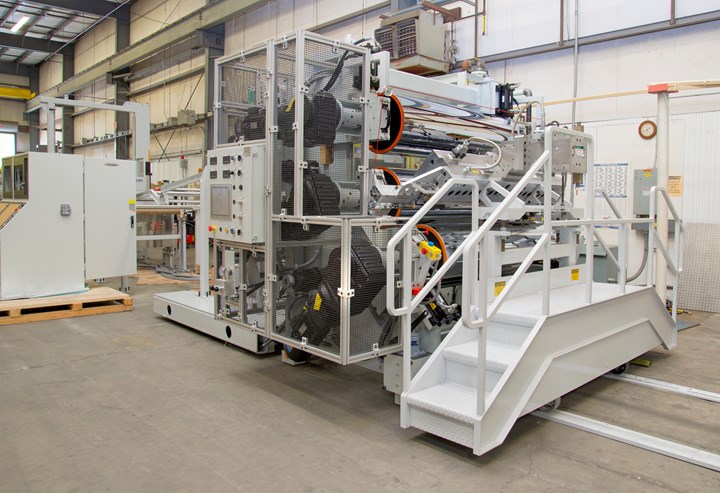
J-stack roll stand in an upstack arrangement. Recommended for rPET, PETG, GP-PS, PP.
In choosing a roll stand, evaluate what type of roll-gap control would be best for your operation. There are three types: manually actuated worm gear; gear motor; and hands-free. Here are the differences:
Manually actuated: Operator-dependent position control; manual sheet-thickness reading to determine gap; optional encoder feedback for display only; adjustable only under reduced pressure.
Gear motor: Operator-initiated position change; encoder feedback; position control; adjustable under full load.
Hands-free: Servo-hydraulic precision roll-position control; linear transducer resolution of 1 micron; closed-loop force control; displays actual force and force-limit capability.
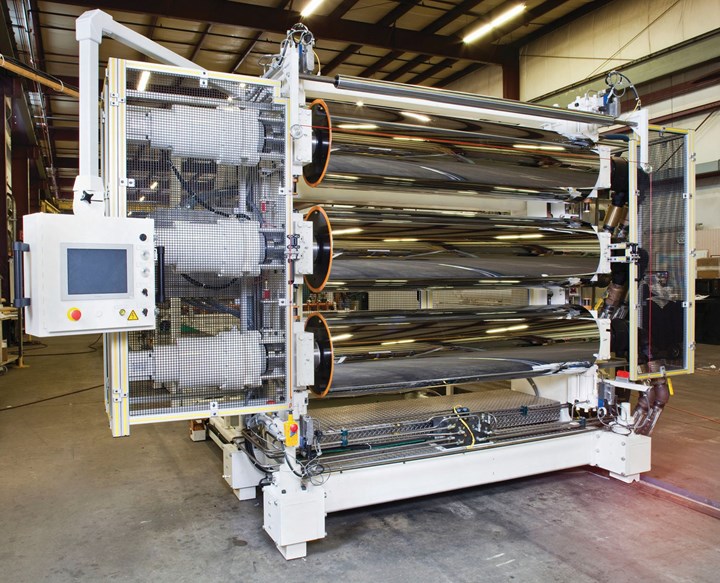
Vertical downstack rolls. Well suited to PMMA sheet extrusion.
In addition, roll-stand systems can be equipped with a variety of features to support processing. These include individual roll drive, protective masking, edge trim, solution applicator, and gauging. New systems come standard with individual roll drive, individual roll-temperature control, and various edge-trim capabilities.
Whether on new or existing equipment, roll-temperature control is critical to proper sheet formation. In additional, roll-temperature ranges vary widely according to the material to be processed, and the TCU will need the ability to achieve and maintain the recommended setpoints listed in Table 3. Some resins and thickness ranges will require high-temperature synthetic fluid systems to achieve proper performance.
A required option in RPET production is protective masking equipment to allow application of a protective film to the sheet in order to deliver it damage-free to the customer. The type of laminate applied will dictate the required options for the let-off machinery. Dual stations are recommended to allow for smooth changeover of laminate rolls as well as side-lay adjustment to ensure proper alignment with the sheet being produced. Quality tension control is essential and can be accomplished with a range of options, from air-clutch resistance to inverter drive control.
Roll-temperature control is critical to proper sheet formation.
In some cases, solution applicators are also needed. A liquid solution is used as the medium to transfer anti-fog additives to the sheet surfaces. Applicators can range in design from the lower-value flood-coating types to higher-value models capable of application at a micron level, such as those used on PET applications.
Once formed, PPE sheet can either be wound on a fixed-station, turret-style winder for thinner material, or cut to length and stacked for thicker gauges. Winders, if not automated, should include accumulators to allow for safe cut and transfer of the web from a full to empty core.
It’s important to have your machine builder come to your plant and do an on-site evaluation of existing capabilities and propose potential upgrades or line additions. For new sheet systems, defining the resins and application specifications helps the OEM properly size extruders, dies and rolls. We also encourage you to take advantage of any laboratory or trial opportunities offered by the OEM to test capabilities.
ABOUT THE AUTHOR: Steven DeAngelis is vp of sheet and foam systems for Davis-Standard, a position he’s held since 2013. He joined D-S in March 1994 as a senior sales engineer for sheet (foam and rigid) and reprocessing extrusion equipment. Contact: 860-599-6150; sdeangelis@davis-standard.com; davis-standard.com
Related Content
What to Know About Your Materials When Choosing a Feeder
Feeder performance is crucial to operating extrusion and compounding lines. And consistent, reliable feeding depends in large part on selecting a feeder compatible with the materials and additives you intend to process. Follow these tips to analyze your feeder requirements.
Read MoreWhy Are There No 'Universal' Screws for All Polymers?
There’s a simple answer: Because all plastics are not the same.
Read MoreUnderstanding Melting in Single-Screw Extruders
You can better visualize the melting process by “flipping” the observation point so the barrel appears to be turning clockwise around a stationary screw.
Read MoreReduce Downtime and Scrap in the Blown Film Industry
The blown film sector now benefits from a tailored solution developed by Chem-Trend to preserve integrity of the bubble.
Read MoreRead Next
At This Sheet Manufacturer, It's Safety First...At Any Cost
Sekisui SPI is an innovative manufacturer of highly engineered, customized thermoplastic sheet. And every pound of it is produced in a ‘safety first’ environment.
Read MoreSheet Processor Adds Capacity in Coronavirus Fight
Laminex is venturing into APET for first time to make PPE in Mexico, after purchasing one of PTi’s demo production lines. The turnkey system will ultimately be used by Laminex for its packaging products.
Read More‘Skew’ Rolls for More Uniform Sheet
New feature aimed at thin-gauge PP sheet.
Read More


